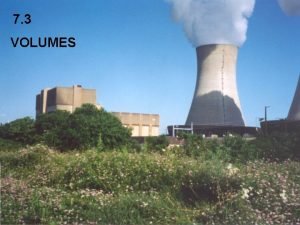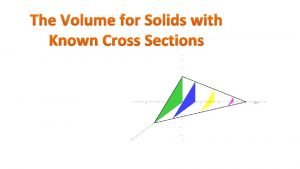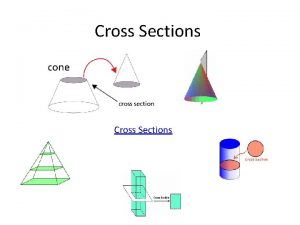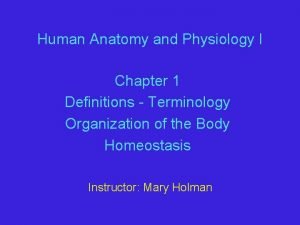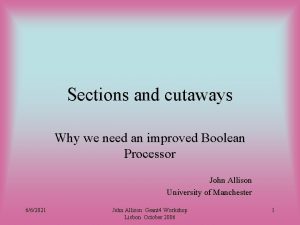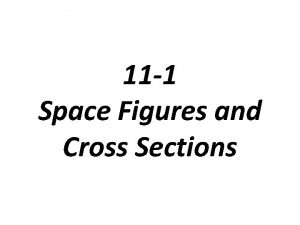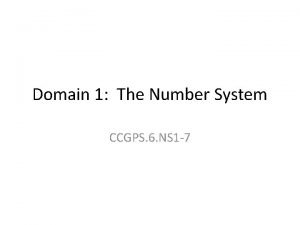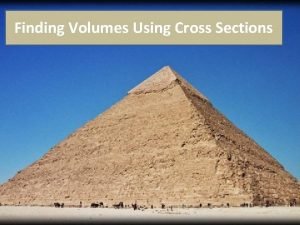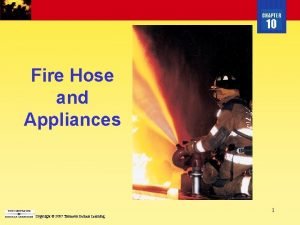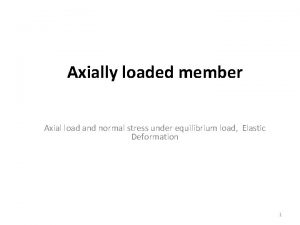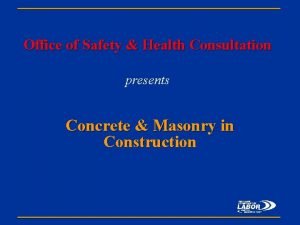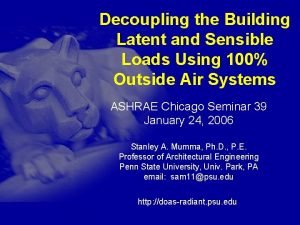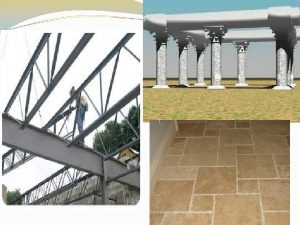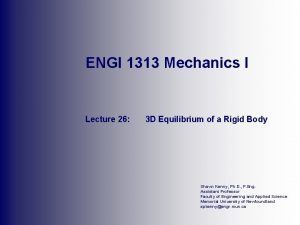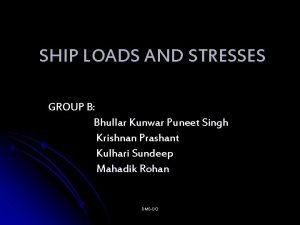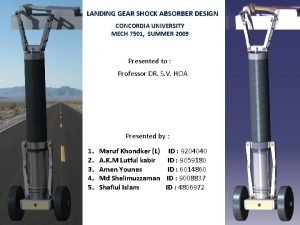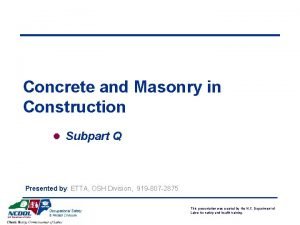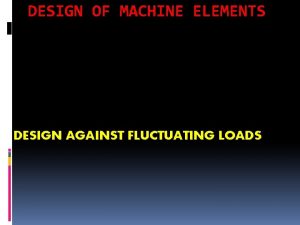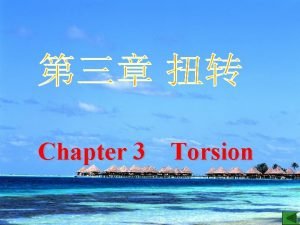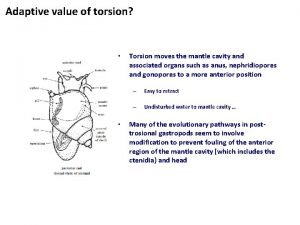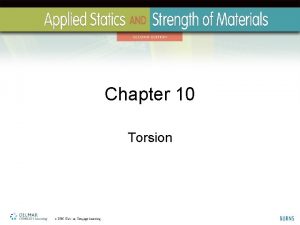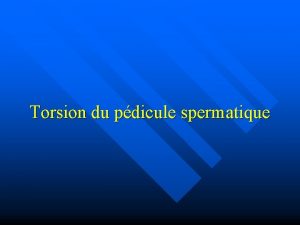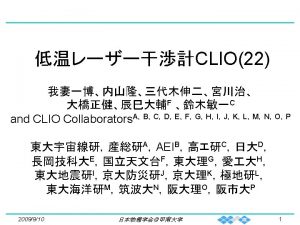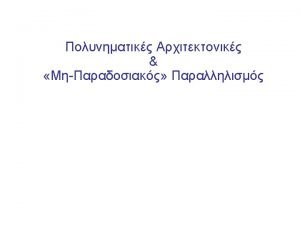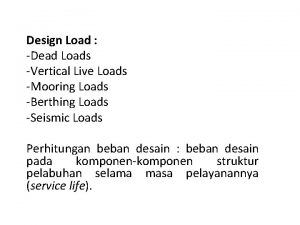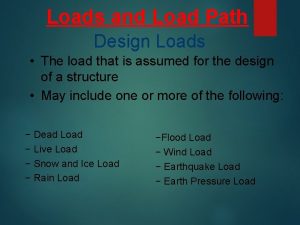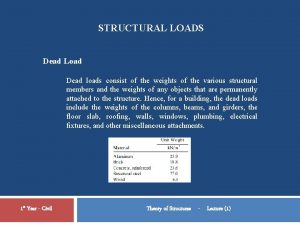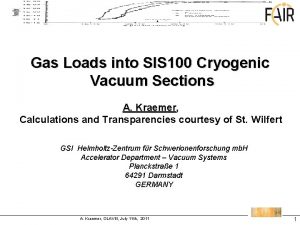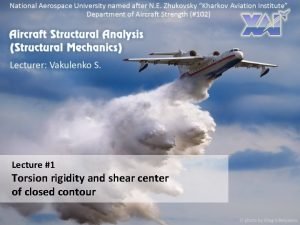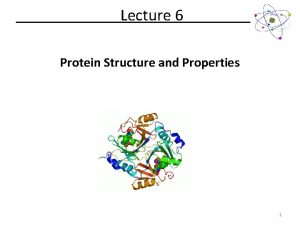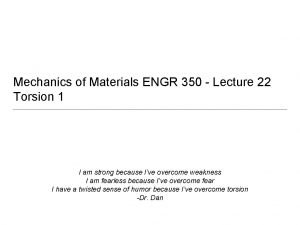Lecture 3 Torsion of opened cross sections Loads




















- Slides: 20

Lecture #3 Torsion of opened cross sections. Loads on frame due to fuselage bending

SHEAR STRESSES RELATED QUESTIONS - shear flows due to the shear force, with no torsion; - shear center; - torsion of closed contour; - torsion of opened contour, restrained torsion and deplanation; - shear flows in the closed contour under combined action of bending and torsion; - twisting angles; - shear flows in multiple-closed contours. 2

SHEAR CENTER AND TORSION - ILLUSTRATION 3

TORSION IN MECHANICS OF MATERIALS The measure of resistance to torsion is a polar moment of inertia Ir. Specific twist angle Maximal shear stress 4

TORSION IN THIN-WALLED CROSS SECTIONS The polar moment of inertia Ir is calculated as a sum for rectangular portions of thin-walled cross section. Specific twist angle Maximal shear stress 5

TORSION IN THIN-WALLED CROSS SECTION Torsional moment is 1000 N·m. Material is steel, G = 77 GPa. Moment of inertia Ir = 4. 14 cm 4. Shear stress tmax = 241. 3 MPa. 6

CALCULATION OF DEPLANATIONS (WARPING) Since the hypothesis of planar cross section is not valid, the beam theory is not applicable. Thus, specific theory developed by Vlasov is used. Vlasov’s theory is based on two main hypotheses: 1) The cross section keeps its shape and rotates as a whole around the shear center. 2) There are no shear strains and stresses at the middle plane (gtz = 0). 7

CALCULATION OF DEPLANATIONS where w – displacement along z axis (deplanation); u – displacement along t axis. where f – angle of rotation of cross section along z axis; r – lever from the shear center to the direction of t axis at the given point. 8

CALCULATION OF DEPLANATIONS where w 0 –displacement at the start point. If start point is set on the axis of symmetry, we get where w(t) – sectorial coordinate (doubled area covered by rotation of radius-vector): 9

CALCULATION OF DEPLANATIONS Analytical values: Max is 0. 67 mm At the corner is -0. 51 mm 10

NORMAL STRESSES AT RESCTRICTED TORSION Normal stresses could be found using the formula where Iw – sectorial moment of inertia: B – bimoment (kind of scalar force factor): 11

NORMAL STRESSES AT RESCTRICTED TORSION The distribution of normal stresses for real structure is usually quite complex, so it is usually wise to use FEA. 12

DISTORSIONAL BUCKLING The open contour torsion theory is also used in the analysis of special buckling modes, called distorsional buckling: • lateral torsional buckling • torsional buckling (flexural-torsional instability) The detailed analytical analysis of these phenomena is quite complicated, so it’s not explained in our course. However, it’s quite important for aerospace engineers. The proper reference for self-study is given on the last slide. 13

DISTORSIONAL BUCKLING Lateral torsional buckling is widely happening in civil engineering structures 14

DISTORSIONAL BUCKLING Flexural-torsional buckling is always analyzed for stringers in aerospace structures https: //www. youtube. com/ watch? v=c. YRic. Tk-Q 08 15

COMPARISON OF OPENED AND CLOSED CONTOURS For a tube of 25 mm diameter and thickness of 2 mm we get: For the closed contour we get the polar moment of inertia of 1. 227 cm 4, while for opened – 0. 021 cm 4, which is 57 times smaller. If we would increase the diameter, the difference will be increased dramatically. Let’s take a thin-walled circle with radius 1 m and thickness of 2 mm. For the closed contour we get 628, 300 cm 4, while for opened – only 1. 67, which is 375 thousands times smaller. 16

LOADING OF FUSELAGE FRAME DUE TO BENDING OF FUSELAGE If the cross section is subjected to bending with moment Mx , the specific normal force is equal to Here d is effective thickness of skin (includes stringers); Ix is moment of inertia for cross section: 17

LOADING OF FUSELAGE FRAME DUE TO BENDING OF FUSELAGE The relative bending angle between two frames fx is equal to Here a is a distance between frames. Normal stresses have a vertical projection due to the presence of bending angle. This projection tends to compress the frame as shown at the figure. 18

LOADING OF FUSELAGE FRAME DUE TO BENDING OF FUSELAGE The distributed load on the frame could found as By making few transformations, we get 19

WHERE TO FIND MORE INFORMATION? Megson. An Introduction to Aircraft Structural Analysis. 2010 Chapter 17. 2 For flexural-torsional buckling, refer to Chapter 8. 6 … Internet is boundless … 20
 01:640:244 lecture notes - lecture 15: plat, idah, farad
01:640:244 lecture notes - lecture 15: plat, idah, farad Semicircle cross section formula
Semicircle cross section formula Cross slice
Cross slice Volumes of solids with known cross sections calculator
Volumes of solids with known cross sections calculator Solids of known cross sections
Solids of known cross sections Perpendicular cross section of a cylinder
Perpendicular cross section of a cylinder Types of cross sections
Types of cross sections Cutaways and cross sections definition
Cutaways and cross sections definition 11.1 space figures and cross sections
11.1 space figures and cross sections Volumes of known cross sections
Volumes of known cross sections Volumes of solids with known cross sections
Volumes of solids with known cross sections Horseshoe load fire hose
Horseshoe load fire hose The copper shaft is subjected to the axial loads shown
The copper shaft is subjected to the axial loads shown Employers must not place construction loads
Employers must not place construction loads Sensible loads in radiant cooling
Sensible loads in radiant cooling Members used to carry wall loads over wall openings
Members used to carry wall loads over wall openings The pipe assembly supports the vertical loads shown
The pipe assembly supports the vertical loads shown Racking stress of container
Racking stress of container Pneumatic shock absorber design
Pneumatic shock absorber design Employers must not place construction loads
Employers must not place construction loads Soderberg equation
Soderberg equation



